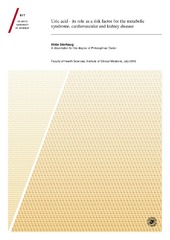Uric acid - its role as a risk factor for the metabolic syndrome, cardiovascular and kidney disease
Permanent lenke
https://hdl.handle.net/10037/11502Åpne
Thesis introduction (PDF)
Paper I: Norvik, J. V., Storhaug, H. M., Ytrehus, K., Jenssen, T., Zykova, S., Eriksen, B. O., Solbu, M. D.: “Overweight modifies the longitudinal association between uric acid and some components of the metabolic syndrome: The Tromsø Study”. Also available in BMC Cardiovascular Disorders 2016, 16:85. (PDF)
Paper II: Storhaug, H. M., Toft, I., Norvik, J. V., Jenssen, T., Eriksen, B. O., Melsom, T., Løchen, M. L., Solbu, M. D.: «Uric acid is associated with microalbuminuria and decreased glomerular filtration rate in the general population during 7 and 13 years of follow-up: The Tromsø Study”. Also available in BMC Nephrology 2015, 16:210. (PDF)
Paper III: Storhaug, H. M., Norvik, J. V., Toft, I., Eriksen, B. O., Løchen, M. L., Zykova, S., Solbu, M. D., White, S., Chadban, S., Jenssen, T.: “Uric acid is a risk factor for ischemic stroke and allcause mortality in the general population: a gender specific analysis from The Tromsø Study”. Also available in BMC Cardiovascular Disorders 2013, 13:115. (PDF)
Dato
2016-12-06Type
Doctoral thesisDoktorgradsavhandling
Forfatter
Storhaug, HildeSammendrag
Uric acid as a potential risk factor for cardiovascular and renal conditions has gained renewed attention. In this work we aimed to assess the associations between serum uric acid, metabolic syndrome, hypertension, renal dysfunction, cardiovascular events and mortality.
In paper I, 6083 participants from Tromsø 4 were stratified according to body mass index. Endpoints were the metabolic syndrome and each component of the syndrome after seven years. Increased levels of baseline serum uric acid independently predicted development of hypertension and higher fasting glycemia in the overweight, but not in the normal-weight subjects. Baseline and longitudinal serum uric acid were both predictors of future metabolic syndrome.
A prospective study that included 2637 participants who participated in Tromsø 4, 5 and 6 was described in paper II. We assessed the associations between change in serum uric acid during follow-up, baseline serum uric acid and renal dysfunction (defined as albumin-creatinine-ratio ≥1.13 mg albumin/mmol creatinine and/or estimated glomerular filtration rate < 60 ml/min/1.73 m2). Participants were stratified according to tertiles of change in serum uric acid between baseline and follow-up 13 years later. The upper tertile, compared to the two lower tertiles, had a doubled risk of renal dysfunction after 7 years, and after 13 years the odds ratio for renal dysfunction was 2.18. The risk of developing albumin-creatinine-ratio ≥1.13 mg/mmol alone was also significantly increased. An increase in baseline serum uric acid of 59 μmol/L gave an odds ratio of 1.16 for renal dysfunction after 13 years.
In paper III, we included 5700 participants from Tromsø 4, and assessed the associations between serum uric acid and all-cause mortality after 15 years, and fatal or non-fatal myocardial infarction and ischemic stroke after 12 years. Serum uric acid was associated with all-cause mortality in men and women, even after adjustment for blood pressure, estimated glomerular filtration rate, urinary albumin creatinine-ratio, drug intake and traditional cardiovascular risk factors. After the same adjustments, serum uric acid was associated with a 31% increased risk of stroke in men. No independent association between increment in serum uric acid and myocardial infarction was observed.
Our findings support the view that serum uric acid is associated with obesity, metabolic syndrome and hypertension, but also is a risk factor for cardiovascular and kidney disease, independently of these risk factors. Moreover, increasing values of serum uric acid over time may imply an even higher risk.
Forlag
UiT The Arctic University of NorwayUiT Norges arktiske universitet
Metadata
Vis full innførselSamlinger
Copyright 2016 The Author(s)
Følgende lisensfil er knyttet til denne innførselen:
Med mindre det står noe annet, er denne innførselens lisens beskrevet som Attribution-NonCommercial-ShareAlike 3.0 Unported (CC BY-NC-SA 3.0)
Relaterte innførsler
Viser innførsler relatert til tittel, forfatter og emneord.
-
Prognostic Impacts of Angiopoietins in NSCLC Tumor Cells and Stroma : VEGF-A Impact Is Strongly Associated with Ang-2
Andersen, Sigve; Dønnem, Tom; Al-Shibli, Khalid Ibrahim; Al-Saad, Samer; Stenvold, Helge; Busund, Lill-Tove; Bremnes, Roy M. (Journal article; Tidsskriftartikkel; Peer reviewed, 2011)Angiopoietins and their receptor Tie-2 are, in concert with VEGF-A, key mediators in angiogenesis. This study evaluates the prognostic impact of all known human angiopoietins (Ang-1, Ang-2 and Ang-4) and their receptor Tie-2, as well as their relation to the prognostic expression of VEGF-A. 335 unselected stage I-IIIA NSCLC-patients were included and tissue samples of respective tumor cells and ... -
The Temporomandibular Joint in Juvenile Idiopathic Arthritis, focusing on Quality of Life, Oral Microbiome and Intervention
Frid, Paula (Doctoral thesis; Doktorgradsavhandling, 2020-10-02)The temporomandibular joint (TMJ) is commonly involved in juvenile idiopathic arthritis (JIA), and may lead to impaired mouth opening, pain and facial growth disturbances. Asymptomatic TMJ arthritis may be diagnosed late in the disease course, thus management is challenging. The overall objectives of this thesis were to provide new knowledge on quality of life (QoL), the oral microbiome and interventions ... -
Humant papillomavirus : en litteraturstudie om HPV, dets relasjon til cancer og tiltak mot videre spredning av virus
Gabrielsen, Endre (Master thesis; Mastergradsoppgave, 2012-06-01)I 1983 oppdaget zur Hausen sammenhengen mellom Humant Papillomavirus (HPV) og livmorhalskreft. På denne tiden visste man ikke at det var HPV som var årsaken til at Helaceller kunne leve in vitro. Ny forskning relaterer HPV til en rekke andre cancertyper. En stor andel anal-, oropharyngeal-, penis-, vaginal-, og vulvacancer skyldes HPV. Det er også påvist HPV i tumorvev fra øsofagus, larynx, lunge, ...


 English
English norsk
norsk



